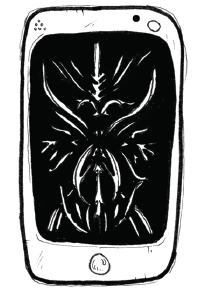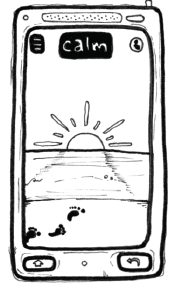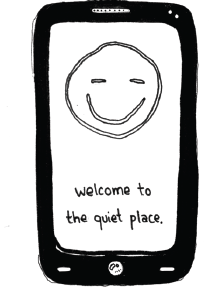In a world of iPhone ubiquity, where people equate happiness with the quality of the latest software updates, our smart phones have become our spirit guides.
To unwind, people choose various modes of “letting go”. For some, this may be heading to happy hour or going out with friends. Others flock to ceramics class, or turn to video games or the nail salon. And there are always those who engage in whatever activity is currently trending, like Soul Cycle or reality TV. It seems that the common solution to stress would be going “unplugged”, but entrepreneurs are pushing serenity technology as a means to find peace and balance in the midst of disorder.

Some device application creators are now focusing on health and wellness apps that encourage users to find their inner focus. Calm.com attempts to use natural sounds like rain drops and chirping birds. Visuals for the app are nature backdrops including ocean water or a slow breeze coasting across a wheat field. A woman’s voice teaches calmness in seven steps to induce a calm effect. The Quiet Place has a minimalistic white screen with words voiced by a soothing British male voice. The voice reminds the user that worrying about e-mail and keeping up with social media is ‘silly.’ Silk, an interactive art app, described as “soothing, trippy and peaceful,” allows the user to create intertwining, colorful strands that weave themselves into a larger piece of art. These apps claim to help people connect to their device, center their mind, body and soul without ever missing their smart phones.
Amitay Tweeto, creator of The Quiet Place app, said his product will help stressed and frazzled tech users. “I believe that these days, everyone is too connected to the virtual worlds and forget about themselves. My app should bring people back to reality and make them remember that there are other things to do and see, rather than the social networks.”
Tweeto expressed his concern with society devoting too much time to trends without realizing how they can be harmful. He urged users to take a break to realize they may be living in a “twisted world”.
YogaWorks Union Square instructor Maya Ray said she supported peace of mind by way of technology. “Anything that is helping people be mindful is all good. Any mindfulness is better than no mindfulness,” Ray said. “If some guy’s voice and fake grass is going to help you get anchored for six minutes, that’s better than nothing at all. Of course, I don’t think that it can replace a good instructor and focused physical practice.” Although Ray doesn’t oppose de-stressing via smartphone, she isn’t fully sold on the overall effectiveness of a wellness app.

The shortcomings of allowing technology to provide much needed relaxation is disputed passionately by Trebor Scholz. “The marketing squats of upstarts come up with terms like ‘serenity technologies,’” said Scholz, a Digital Activist, founder of the Institute for Distributed Creativity and a Culture and Media Studies professor at The New School. “If you want to relax, get rid of all these apps and screens, and get a life. Make out under a tree, try a cartwheel in the park, or bike over the Williamsburg Bridge,” he said. “Instead of buying into these marketing schemes, think about how we can make some radical use of some of these technologies. How could they truly enhance the quality of our lives? What we need is a digital-self defense, that makes you immune to fads.”
The International Center for Media & the Public Agenda asked 1,000 students worldwide to go “un-plugged,” without using their devices for 24 hours. In response, 23 percent of U.S. students reported feelings of addiction to their devices and media. Anxiety UK conducted a survey reporting forty-five percent of participants felt waves of anxiety when access to devices, social network notifications and e-mail was unavailable.

Alex SooJung-Kim Pang, business consultant and author of The Distraction Addiction, raised the possibility of reigning in our use of technology and social media to our benefit. He suggested that users need to learn to control the Internet and its offerings and distractions instead of being overtaken. Pang encourages users to “tweet mindfully.” In his book, Pang broadens the process of mindful tweeting. Broadening the term he writes, “Tweeting mindfully means knowing your intentions, knowing why you’re online right now and asking yourself if you’re on for the right reasons.”
In the New York Times article “How Yoga Can Wreck Your Body”, instructor Glenn Black explained that he pushes each yogi to a high threshold of pain, the stopping point is discretionary. While there are endless opportunities to get lost using apps and browsing the web, it is up to the user to know when to tap out.” Black’s honesty sends a reminder that everything good should be done in moderation, if done at all.
Reporting by NiQyira Rajhi








Leave a Reply